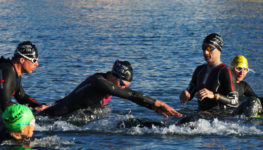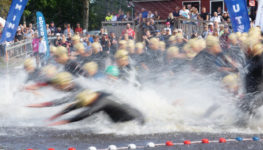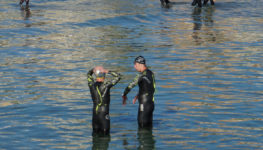Our buoyancy debate input – part 1
The buoyancy debate surrounding swim training is one of those never-ending topics; is it good, bad, or indifferent?
Pull buoys and, more recently, buoyancy shorts have received a divided reception in the triathlon world. There are generally three view; additional buoyancy is beneficial, some simply use it to make life easier / more enjoyable and others see it as a cheat that masks development.
Which of these three camps are you in?
Our input to the buoyancy debate
As coaches, our job is to build healthier, faster and more confident athletes. All our athletes use added buoyancy when swim training and everyone who has followed our approach has progressed. The way we coach has had proven results with faster times and boosted confidence (in open water events – wetsuit or non-wetsuit).
In Part 1 of our contribution to the buoyancy debate, we will address why the traditional swim training / coaching approach for ADULT, non-swimming triathletes does NOT work.
Buoyancy IS good
We are firmly in the “buoyancy is beneficial” camp and will explain how we use buoyancy to help ADULT, non-swimming specialists develop a style of swimming that is effective for TRIATHLON. And we are not the only ones; the two obvious and most successful coaches to refer you to Brett Sutton of Trisutto and Joel Filliol of the JFT Crew. These two coaches train all their athletes (World Champs through new age groupers) use pull buoys and other tools – all the time.
Most triathletes (adults and even male competitive swimmers**) tend to agree that the added buoyancy is a great help; on the other hand, there are traditional swimmers (females) / coaches who don´t like the feeling of the extra lift prefer not to use any.
**Matt, MoT coach, is an ex-swimmer and knows for a fact that most of his male swimmer counterparts loved using pull buoys (buoyancy shorts weren’t around back then!) when swimming because it made swimming easier and faster.
Among other reasons, men tend to have a higher muscle mass than women and less stored body fat (it’s the way we are designed!), especially in the leg area. Men’s legs are denser because they have more muscle mass and less body fat to float them.
You may ask: “How can a competitive swimmer be fast when using a pull buoy?” FYI, just because you use a pull buoy it doesn’t mean you stop kicking; if anything, you can develop an effective, natural and tight kick movement better with a pull buoy than you can fins or kick drills!
Coaching terminology
Before explaining our rationale for using buoyancy, lets change the terminology from buoyancy AIDs to buoyancy TOOLS. This simple change does wonders for how people view their training and their development. Psychologically, language can make a huge difference to how we view things. Coaching is all about finding ways to get the best out of people and word play is a large part of being a better coach. The right coaching cues make all the difference.

We associate AID with rescue, or assistance, or weakness. A TOOL is something we use to build something – we are building performance and confidence.
Swimmers are different to triathletes – the root cause of the buoyancy debate
We have coached swimmers (aged 5 to 65) to National level in Competitive/Masters swimming and triathletes (of all ages) to World Championship level. And yes, there is a difference in our approach when coaching swimming for swimmers and swimming for triathletes – explained later.
The problem is that we see too many self-taught triathletes (and triathlete coaches) approach swimming as swimming – treating adult triathletes as competitive swimmers. This approach DOES NOT work effectively. There is too much focus on technique (that they will never attain but tradition says they should, and coaches believe they must, if for no other reason than they “should”).
This is where the buoyancy debate stems from; the conflicting approaches of swimming for competitive child swimmer and how to get the best out of adult non-swimmers.
Entering a sport in adulthood
Most triathletes enter the world of triathlon with no, or very little swim background. Anyone starting triathlon as a new sport at a mature age should be commended! Unfortunately, though, it means that the triathlete must accept some limitation! A mature athlete just can´t do what an athlete who has mastered a sport in childhood (or specifically pre-puberty) can do.

Some sports are relatively easy to learn / perfect (but not master) at a mature age – cycling and running are relevant examples. There are, however, a few notoriously difficult / high skill sports that ADULT entrants will struggle to learn and perfect. For the triathlete, it is unfortunate that swimming is one of them (gymnastics, diving and Olympic lifting are other truly difficult sports to approach in adulthood).
As noted by Brett Sutton: the ‘favoured techniques’ and claims as to the absolute fastest way, have been developed by studying the world’s best athletes. It is here that we should all understand that in swimming no one is at the top of the tree that hasn’t swam for about 6 years and a minimum of 50km or more on average per week.
The Australian Fitness Network reports even more fundamentally that “Children do not automatically become proficient at sports. Some will be naturally more adept than others, but they all need to be taught fundamental motor skills and given the opportunity to progress through stages”
The above may seem negative, but you should view this information as a reassurance that you CAN learn and become effective at the simple movement patterns that you are able to do. Develop what you can do and DON´T try to copy what a pure / single sport athlete does.
Why adults cannot master high skill sports
The key element most people (athletes and coaches) overlook in the buoyancy debate is that adults cannot learn movements in a way that children can. There MUST be a different approach, one way for ADULTS and one way for CHILDREN. Both are right, but they are different.
Fundamentally, adults cannot master certain sports because neuromuscular pathways (motor neurons – pictured below) have already been established – and they don´t match those required to swim like a swimmer!

A study investigating the ability to acquire golf skills (often cited to be a technical sport much like swimming) found that “Even in skilled golfers, the age at which training commences plays a role in the memory processes supporting performance, … suggesting that they rely more heavily on proceduralized skill representations (hard wiring) than late learners”
A swimmer who has been swimming through childhood and puberty / maturation has accrued hundreds and thousands of hours of movement replication while the body was still developing. The movement of a swim stroke will have been developed, refined and “written” or “hard-wired” into the body’s neuromuscular highway. It is simply NOT possible to acquire this wiring in adulthood.
The benefit adults have over children is that they are much stronger. Children who effortlessly whiz up and down the pool are not stronger than adults, they are more technically efficient. Learning the simple arm actions (see movement patterns, below) will allow adults to use their strength in a way that can enable fast swimming, but probably not as “elegantly” as the children!
Approaching swimming in a way that is suited to ADULTS, whether it is for triathlon, Masters swimming or recreation, results in a much more enjoyable journey that speeds development and speed!
Think movement patterns, not technique
The competitive nature of adults, and especially triathletes, means they are keen to learn and progress. This also means they spend time researching how to swim – and end up knowing too much!
Unfortunately, standard advice from the media, coaches, etc is to do a lot of swim technique work (borrowed from the competitive swimming world). “Do this, do that” – the list is endless. The problem is that most of what they know is simply not relevant because adult body’s simply won´t allow them to do what is advocated.
Progression is achievable with the right training. However, the triathlete who spends a lot of time doing technique work is the one that has a very slow rate if progression.
When coaching, we remove the need to think about technique and focus instead on very simple (arm) movements. Using TOOLS (buoyancy, paddles and bands) where appropriate makes it even easier.

The lack of the neuromuscular “wiring” or pathway means that adults lack the awareness and precision to make their limbs perform in exact ways. Keeping it simple allows them to develop the key movements quicker.
If you try to perform and master the swim drills that are commonly advised, it WILL confuse your neuromuscular system and even make your swim stroke “technically” worse (we have seen it)! Not only that, the triathlete become increasingly frustrated as they see their swim development plateau. The other big frustration being their “swim” friends and coaches. They keep nagging them about movements they physically cannot do (no matter how hard they try).
Adult movement patterns
Our approach for coaching a non-swim, adult triathlete is very simple:
- Learn the simple movement patterns needed for a strong and effective ARM action (stroke) – while integrating breathing
- Place – hand entry into the water;
- Press – hand drops QUICKLY to point fingers downwards;
- Push – back fully, and then
- Recover – in a way that is relaxed (we´re not interested how, if it is relaxed).
- A large amount of emphasis should be placed on the importance of the PUSH phase of the arm movement. The PUSH it the only propulsive stage of the arm path (the place and press only provide LIFT).
- Develop the PUSH, make it strong and consistent and the legs will lift.
- We use the image of a water skier being pulled by a speed boat. If the boat pulls the skier slowly, the skier will sink or sit low in the water. If the boat speeds up, the skier will rise.
- Power at the front will lift the rear because the body is powered forwards and the water flow under the body lifts the legs.

- Only when these very simple actions have been learnt and breathing is consistent do we tweak the movements.
Apply buoyancy!
Using buoyancy tools helps in the development of the arm action because they help lift the lower body.
Lifting the legs and positioning the body in an aligned position makes it “easier” to perform the simple movements outlined above. Yes, this may initially “mask” a poor body position but quickly pays big dividends as the arms start to be propulsive.
The buoyancy tool means:
- The legs no longer sink and add drag
- The shoulders are positioned in a way that no longer impinges the muscles, ligaments and tendons – better posture
- The PUSH stage is much easier to perform; the range of movement and position allows the recruitment / use of more muscle without impinging the shoulder at the exit point
- The movements are simplified because the swimmer doesn’t have to try to kick to create lift.
Consistently training this way, and you will ultimately negate the need for buoyancy tools!
Note, when our athletes use buoyancy tools they do NOT stop kicking. This is a common error, people think they must stop kicking, this leads to tensions, leg drop, cramp, etc. Instead, let the legs find a natural rhythm and don’t think about them – focus on the arm movements!
Why we use buoyancy to reduce kick “thought”

We ban kicking drills, but don’t ban kicking.
We want a natural, automatic kick to occur with or without buoyancy tools. Being automatic, or subconscious, is the key.
Kicking just is not conducive to triathlon like it is to swimming. We just reduce kick thought, utilisation and “reliance” (the arms do all the work needed and provide lift).
Kicking is expensive – it uses a LOT of energy and tires the neuromuscular system. Remember, in triathlon you will have to cycle and run after the swim. Swimmers need to kick to get the most out of the body and reduce times, but they don’t have to do anything else afterwards!
Kicking in a triathlon will hinder the bike and run; it uses vital energy, it strains the cardiovascular system and burns out the neuromuscular system.
Kicking to remove head-spin
Lastly, you often hear that kicking harder in the last 50m of a swim removes head-spin issues upon standing. This is not true, blood will be flowing in the legs ALL the time (unless you are jet pilot!!). The issue is that triathlete exit the swim too hard and run too hard to transition without proper BREATHING control. Not because there is no blood in the legs!
Conclusion
Recapping part 1 of our buoyancy debate and why we use buoyancy tools:
- Adults non-swimmer triathletes just cannot learn the advanced movement patterns of a competitive swimmer. Competitive swimmers will have learnt the skills through puberty / maturation, hard wiring neuropathways.
- This is not a negative statement, instead a release of pressure and expectations. Forget the “technique” side of swimming and focus on the simple movement patterns needed for a strong arm stroke.
- Pay close attention to developing a strong PUSH in every session with the correct swim tools – buoyancy, paddles and an ankle band. A strong PUSH will create more propulsion and lift the body, with or without a buoyancy tool. Meaning you WON’T become reliant on the tool.
- Kicking is not conducive to triathlon like it is to competitive swimming. Reduce kick focus and hone in your arm movements – the PUSH!
In Part 2, we will address why people become reliant on buoyancy and our approach to coaching.
Age of Acquisition in Sport: Starting Early Matters, Arturo E Hernandez, Andrew Mattarella-Micke, Richard W.T. Redding, Elizabeth Owens Woods and Sian Beilock.



